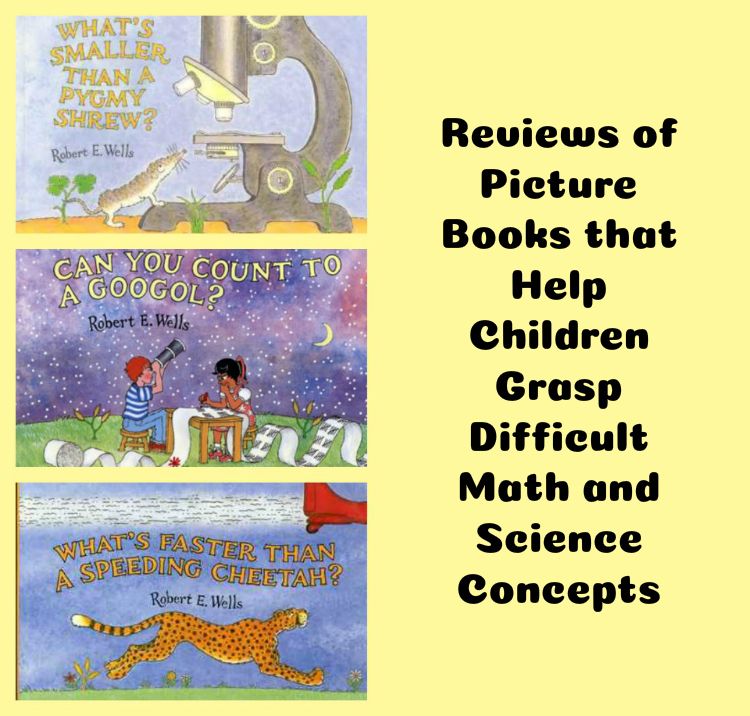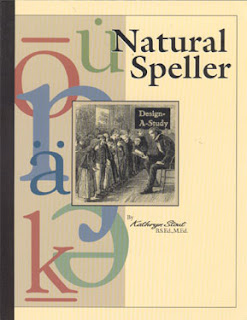Picture Books Clarify Science and Math Concepts
Big, small, tall, fast, heavy, old -- what do these words mean? Maybe each person has a different idea about them. Author and artist Robert E. Wells wrote a series of books, The Wells of Knowledge Science Series, that illustrates these concepts. Although they seem to be about math, math is so tied to science that readers will learn a lot of science as they grapple with math concepts. Even though these are picture books designed for children, I confess I also learned a lot from them.
What's Smaller Than Pygmy Shrew?
What does the word "small" suggest to you? A marble? A bee? Robert Wells introduces his world of the small with a pygmy shrew, which is three inches long. He then challenges readers to think of what's smaller. He contrasts the shrew with an elephant, which in comparison makes the shrew look very small indeed. He then contrasts the shrew with the ladybug, which is smaller yet.
Then he introduces the creatures that can only be seen under a microscope -- the ones you might find in a drop of water. He explains what cells are and then shows us the animals with only one cell -- the paramecia and amoebas which are both protozoa. Wells' imaginative drawings will bring them to life for you and younger readers. Before Wells is through, he has explained and drawn bacteria, molecules, atoms and their parts, and has challenged readers to guess how many atoms are in a pygmy shrew. There is a small glossary at the end to help children remember unfamiliar words.
Is a Blue Whale the Biggest Thing There Is?
In this book, Robert Wells explains to all ages the relative sizes of large from a blue whale all the way to the whole universe. The opening picture shows an elephant, horse, and lion standing on a pier watching the tail of a blue whale that is larger than all of them combined. Then he shows the same animals looking at a jar that contains 100 blue whales. He then puts two such jars on a platform with the animals between them.
With the animals still standing on the bottom platform, Wells draws a stack of platforms ten high and then on the next page puts them on top of Mount Everest to show how small they are in comparison. By this time the animals are no longer visible. Wells goes on and on until he reaches the universe itself, having introduced numbers in the millions and billions along the way. Even adults will find this book, and others in this series fascinating.
Readers then learn about the speed of sound and space travel as all the characters get into a rocket ship. Just as we see a meteoroid whizzing by, we learn that all of us have something that's even faster – something we can hold in our hands. The book concludes with is a chart comparing how long it would take at all the speeds from runner's feet to light to get from the earth to the moon.
When I was homeschooling, I was always on the lookout for engaging books that targeted visual learners. These books fit into that category. Jason understood what he could see better than what he only read or heard. He was a hands-on kind of child. He also loved animals, and all three of these books have some animal characters.
One of more of these books could fit into a unit study about light, sound, astronomy, biology, chemistry, physics or transportation. Instead of just reading a definition for a word like protozoa, a child will see a large illustration showing its relationship to other objects it is part of, as well as things that are part of it.
See all the books in The Wells of Knowledge Science Series, which are recommended for ages 7-10. I believe they are good also for those over ten who want to understand these science concepts. The pictures are imaginative and fun and keep science from being dull. I suggest you get a physical edition rather than a Kindle edition because your children will want to pour over these books. I wish I'd had these for my own children, but they weren't written yet back then.
Find more of my reviews for picture books at Books to Remember.
If you found this page useful, please share it at Pinterest.
What's Faster than a Speeding Cheetah?
This book explores speed from that of the ostrich and cheetah to the speed of light. I love the illustrations which show the race between some children, an ostrich, a cheetah, a swooping peregrine falcon, and a propeller plane. Soon the children, ostrich, and cheetah are in the plane with a frustrated falcon trying to catch up. The falcon then lands on the tail of a jet and passes them.
Readers then learn about the speed of sound and space travel as all the characters get into a rocket ship. Just as we see a meteoroid whizzing by, we learn that all of us have something that's even faster – something we can hold in our hands. The book concludes with is a chart comparing how long it would take at all the speeds from runner's feet to light to get from the earth to the moon.
These Books Are Great for Unit Studies in Home Schools
What's Faster Than a Speeding Cheetah? (Robert E. Wells Science Series)How Do You Lift a Lion? (Wells of Knowledge Science Series)Is a Blue Whale the Biggest Thing There Is? (Wells of Knowledge Science Series)Can You Count to a Googol? (Wells of Knowledge Science Series)What's Smaller Than a Pygmy Shrew? (Wells of Knowledge Science Series)
The Wells Knowledge of Science Series is Ideal for Unit Studies
When I was homeschooling, I was always on the lookout for engaging books that targeted visual learners. These books fit into that category. Jason understood what he could see better than what he only read or heard. He was a hands-on kind of child. He also loved animals, and all three of these books have some animal characters.
One of more of these books could fit into a unit study about light, sound, astronomy, biology, chemistry, physics or transportation. Instead of just reading a definition for a word like protozoa, a child will see a large illustration showing its relationship to other objects it is part of, as well as things that are part of it.
See all the books in The Wells of Knowledge Science Series, which are recommended for ages 7-10. I believe they are good also for those over ten who want to understand these science concepts. The pictures are imaginative and fun and keep science from being dull. I suggest you get a physical edition rather than a Kindle edition because your children will want to pour over these books. I wish I'd had these for my own children, but they weren't written yet back then.
Find more of my reviews for picture books at Books to Remember.
If you found this page useful, please share it at Pinterest.
Note: The author may receive a commission from purchases made using links found in this article. “As an Amazon Associate, Ebay (EPN), Esty (Awin), and/or Zazzle Affiliate, I (we) earn from qualifying purchases.”

































